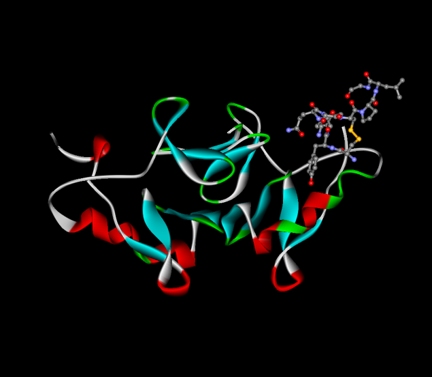Oxytocin, popularly called the love hormone, is a molecule that regulates activity in an array of brain systems and organizes behavior over a very wide spectrum. Just how it does this is a matter of deep interest to neuroscience.
Oxytocin is a peptide (nine amino acids) produced in the hypothalamus, stored and secreted from the pituitary gland. It is a classic example of a neuromodulator that influences very elaborate behaviors, for example; childbirth, maternal bonding, lactation, orgasm, social recognition, pair bonding, anxiety, trust and empathy, and ethnocentric behaviors. The oxytocin receptor, OXTR, is distributed widely in the CNS and its structure, cellular function and gene sequence are all well known.

Oxytocin (ball-and-stick) bound to its carrier protein neurophysin (ribbons)
Oxytocin’s story began in the early 1900s, when it was found that a substance from the posterior pituitary gland promotes labor contractions and lactation. The hormone was named oxytocin after a Greek phrase meaning rapid birth (you may know it as Pitocin). By the 1970s, it was clear that the neurons that produce oxytocin send projections throughout the brain, an indication that the hormone plays a wide role in the regulation of social behaviors. Current research is generating an expanding view of what oxytocin does and how it works at the cellular and molecular level. Sue Carter, Director at the Kinsey Inst. at Indiana University, phrased it this way, “This is a very ancient molecule. It has been used and reused for many purposes across the evolution of modern animals, and almost everybody who’s tried to look at an affect of oxytocin on anything like social behaviour has found something.” “Oxytocin is part of a system,” Carter says, “and it’s not the only molecule that matters, but it’s one that in some way is regulatory over a large number of other systems.” The issue at hand is to learn how oxytocin works to alter behavior, because that is certainly what it does!
Reprogramming the Brain with Oxytocin
Robert Froemke and colleagues at NYC’s Langone Medical Center have been reprogramming the brains of virgin female mice with oxytocin. Before the treatment, the mice were indifferent to the cries of a distressed infant. But after an injection of oxytocin, they started to respond more like mothers, caring for the mewling pup. The research team focused on neurocircuits in the left auditory cortex, the area involved in detecting the pups’ ultrasonic cries. At first, the recordings were just an irregular smattering of neural impulses. Then, as the oxytocin kicked in, the signal evolved into the more orderly pattern typical of a maternal brain. Their finding was that oxytocin temporarily suppresses inhibitory neurons, those that dampen neural activity, allowing excitatory cells to respond more strongly and reliably to the auditory signal.
Richard Tsien, also a neuroscientist at Langone, studies the action of oxytocin on neuronal circuits in the hippocampus, a region deeply involved in learning and memory. Tsien’s team found that oxytocin selectively acts on inhibitory interneurons in a way that quiets background chatter in the circuit. Tsien concluded that “Oxytocin improved signal transmission, almost doubling the ability of information to flow through the system.”
Both Froemke’s and Tsien’s work fit into a broader theory; that one way oxytocin helps social interaction is by acutely enhancing the brain’s response to socially relevant sights, sounds and other stimuli.
Oxytocin is not the only player. Robert Malenka at Stanford showed that oxytocin works in concert with the neurotransmitter serotonin (5-HT) to modulate the excitability of neurons in nucleus accumbens, a brain region deeply involved in reward. The effect is to support the preference of mice to return to environments where they had rewarding social interactions with other animals.
From these and many other studies, it is clear that oxytocin helps to transform the brain in ways that broadly influence activity in neural systems involved in social behaviors, reward, and perhaps learning and memory, as well.
A Matter of Trust
Psychologists have shown that single doses of oxytocin, delivered as a nasal spray, promote various aspects of social behavior in healthy adults. People who inhale oxytocin before playing an investment game are more willing to entrust their money to a stranger. Oxytocin increases the amount of time that people spend gazing at the eye region of faces, and improves their ability to infer the emotional state of others through observing subtle expressions.
Paul Zak, a neuroeconomist, writing in the Wall Street Journal says that, “In our blood and in the brain, oxytocin appears to be the chemical elixir that creates bonds of trust not just in our intimate relationships but also in our business dealings, in politics and in society at large.” Zak is an enthusiast, keep that in mind and if you don’t believe me, view his TED talks. But read on because there is insight to be gained.
In Zak’s view, when someone’s blood oxytocin level is high, they are more likely to be generous and caring, even of strangers. He tested that idea by administering oxytocin via nasal inhaler and found that the behavioral trust response could be turned on and off. Zak concludes: “This isn’t to say that oxytocin always makes us good or generous or trusting. In our rough-and-tumble world, an unwavering response of openness and loving kindness would be like going around with a “kick me” sign on your back. Instead, it works like a gyroscope, helping us to maintain our balance between behavior based on trust and behavior based on wariness and distrust. In this way oxytocin helps us to navigate between the social benefits of openness and the reasonable caution that we need to avoid being taken for a ride.”
 A bride and groom having blood drawn for oxytocin assay
A bride and groom having blood drawn for oxytocin assay
Zak and his team attended a wedding in the English countryside as rather unusual guests. The idea was to see if the wedding would alter levels of oxytocin in the attending friends and family, as well as in the bride and groom. They came prepared to do a lot of blood draws. The bride’s oxytocin level went up 28% during the ceremony. For the others, their oxytocin levels seemed to go up in proportion to the likely intensity of their emotional attachment to the event. The mother of the bride, 24%. The father, 19%. The groom, up 13%, etc. Why was the groom’s increase lower than the father of the bride’s? Testosterone interferes with oxytocin release, and the groom’s blood level of testosterone doubled during the ceremony!
The wedding experiment seems to illustrate the kind of graded and contingent sensitivity to social stimuli that would allow oxytocin to create a balance between trust and distrust, generosity and self-protection. Maybe, but this is likely to be an oversimplification and you will realize at once that the interpretation is full of inference. But, it is a fun thing to think about.
Oxytocin and Puppy Bonding
If you are a dog owner you know that your canine friend spends a good deal of time looking into your eyes, holding your gaze. The astonishing thing, as the authors of a paper in Science point out, is that dogs have evolved to use one of the “human-unique social cognitive modes”, namely employing eye contact to form positive social bonds.

In their study people and dogs were paired-up for 30 min play sessions and oxytocin levels in urine were measured before and after. They found that when dog owners had lengthily eye contact with their pets during the play session their oxytocin level increased significantly. The dog experienced the same oxytocin increase. Then they used oxytocin nasal spray. Female dogs gazed more deeply after a shot of oxytocin, and the owners also experienced a greater increase in oxytocin, although in their case through the social interaction alone. The cool interpretation is that eye contact promotes a relationship-loop in which both participants experience an increase in brain oxytocin. The positive feedback reinforces positive social cues serving to strengthen trust, somewhat like the mother-infant bond. Marc Bekoff wrote a nice article on this topic. By the way, oxytocin spray enhances social interactions between dogs, as well. This doesn’t work with wolves, so it is not just something about social canines. This suggests that the oxytocin relationship-loop co-evolved in people and dogs during our long history together. That would be something worth looking into!
The Broad Influence of Oxytocin
Love, Sex and Oxytocin – A study published in 2012 examined oxytocin levels in new lovers versus single people. The result; levels of the hormone were high in the first stages of romantic attachment, and this was sustained for six months or so in the couples that stayed together.
In both men and women, sexual intercourse stimulates oxytocin release into the blood, and this has a role in erection and orgasm (oxytocin is also produced in the uterus). The reason for this is not fully understood, although in women, it is proposed that the increased uterine motility may help sperm to reach their destination. Some researchers believe oxytocin may play a part in the experience of sexual orgasm, proposing a correlation between the concentration of oxytocin and the intensity of orgasm (The Science of Orgasm, Komisaruk BR, et.al. The Johns Hopkins University Press, 2006).
Mother Infant Bond – There is strong data pointing to oxytocin as a driver of maternal-infant bonding, with the amount of oxytocin in both parties correlating with the duration of the mother-child gaze. Moreover, mothers with a high oxytocin response maintain their gaze during infant distress but those with a low oxytocin response reduce their gaze in those situations.
Face Recognition – Face blindness (prosopagnosia) is temporarily improved following inhalation of oxytocin. In face blindness a person cannot identify the faces of family and friends, even their own face. Nasal oxytocin improves the ability to remember faces and to match pictures of faces of the same individual. The persons in the study had a developmental form of the condition and had never been able to recognize faces; this is pretty common and affects about 1 in fifty people. The positive effect of oxytocin lasted 2-3 hours. It is unclear what’s going on, but the findings are consistent with an increase in activity in the brain’s distributed face recognition network, something that might result from a temporary relief from inhibition in sensory pathways.
Monogamy – Oxytocin stimulates the reward center in the male brain, increasing partner attractiveness and strengthening the draw toward monogamy. That’s interesting, particularly because monogamy is not at all common in mammals. Researchers used fMRI imaging to follow activity in the reward system while men were shown pictures of their wives or other women. They found that when given nasal oxytocin, the neural response to pictures of their spouse was enhanced. Importantly, the enhancement was specific and did not generalize to other women or female friends or colleagues. So, love is the drug after all.
Enhanced emotional sensitivity – Oxytocin turns up our social systems, enhances our emotional sensitivity and it makes people feel more extroverted. Mark Ellenbogen, Chair of Developmental Psychopathology at Concordia University, had this to say about his work; “Our study shows oxytocin can change how people see themselves, which could in turn make people more sociable … Under the effects of oxytocin, a person can perceive themselves as more extroverted, more open to new ideas and more trusting.”
Group Cohesion – Generally, the higher the level of oxytocin, the more empathy and trust a person will feel and the lower their social anxiety and fear. Oxytocin promotes group bonding. In fact, people are willing to bend ethical rules to help the people close to them, like team members or family. Oxytocin can also stimulate aggression, if it is required to protect the group.
On the Cautionary Side
All the recent science has kicked off an oxytocin fever. It is clear that its effects on human behavior are complex and nuanced. It is also clear that the effects of oxytocin spray depend very strongly on the individual, so it makes good sense to be cautious. Sue Carter comments, “This is not a molecule that people should be self-administering or playing with.”

Various research groups conclude that oxytocin sniffs can make people more trusting, generous, cooperative and sensitive to the emotions of others. But other researchers find that oxytocin boosts envy and schadenfreude, as well as favoritism toward one’s own clique.
Jennifer Bartz, Mount Sinai School of Medicine, found that responses to exogenous oxytocin depend on a person’s mindset and she showed that oxytocin hinders trust and cooperation among people with borderline personality disorder. When Bartz reviewed the early oxytocin studies more closely, she saw that around 50% of them showed that the hormone enhances positive behavior only in certain situations or certain individuals. Look here for a well written cautionary essay.
We live in a culture filled with glowing advertisments for supplements and placebos. Recreational and off-label oxytocin gets its share of hype. For example, because of the positive effects of oxytocin on social behaviors, parents of kids with ASD are buying unregulated nasal sprays (a number are available on Amazon, but quality and dosage are not assured) in order to give oxytocin to their children. Clinical studies, and there are lots of them, have never been able to show that there is benefit to this, and the long-term consequences are completely unknown. While I understand the motivation, I fear the outcome. In another realm entirely, some clinical psychologists are doing research and publishing comparisons of the effects of oxytocin spray with the effects of MDMA (ecstacy, molly), alone and in combination. This is a really hazy area, and MDMA is an illegal drug. You wonder if these people anticipate oxytocin being the next underground rave phenom.
Sue Carter’s group pointed to a potential downside to exogenous oxytocin. Studying social prairie voles, they found that a single low dose of the hormone given to baby prairie voles improved their pair bonding as adults, but that higher doses had the opposite effect, possibly because high dose oxytocin interfered with normal neuro-development. Human studies show that in certain contexts, a puff of oxytocin can cause people to be more aggressive in defending themselves against outsiders or competitors. Diverging effects like these should not come as a surprise because complex systems, and human behavior is certainly one, do not behave in a linear fashion and outcomes are not predicable without knowing the system in great detail, if then.
Oxytocin research is benefiting from a combination of approaches ranging from basic neuroscience and genetics to clinical research. One huge motivation for neurobiologists is the opportunity to learn how a neurochemical like oxytocin manages to organize so many brain systems to produce a cohesive behavioral output on so many levels, all at once. After all, it is mind blowing.
-Neuromavin

